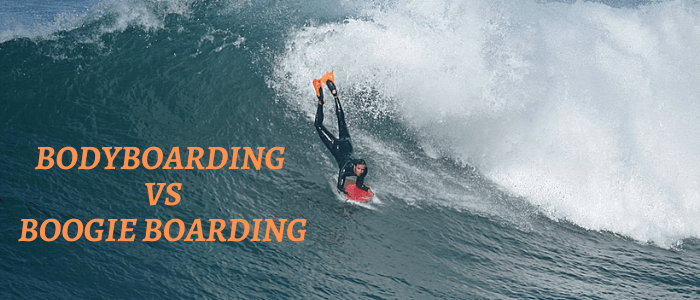Boogie boarding and bodyboarding are similar sports that you can do in the water. They both require a board, some waves, and an ocean to have fun. But what is the difference between a boogie board and a bodyboard? Boogie boards are more like surfboards while bodyboards are more like skimboards. Bodyboards are smaller than boogie boards because they’re meant to be held by one person rather than sitting on top of them for two people. If you want to know how these differences impact your surfing experience then keep reading!
bodyboard vs boogie board
Fins
Bodyboards also have fins on either side that allow them to move forwards or backward, whereas most boogies don’t or their fins aren’t as pronounced. This means when you’re riding waves with a boogie board then if there’s any frontal breaking point (wave curling) your front foot will go underwater, but with a bodyboard, this won’t happen since the rider is positioned in such a way so they can stay up higher on top of the wave without touching the water.
Size
Boogie boards are typically larger, more buoyant, and have a wider surface area. Bodyboards are smaller, less buoyant, and have a narrower surface area.
A boogie board can be used on any type of water while a bodyboard should only be used in waves or surf.
Material
A boogie board is usually made out of polyethylene foam while a bodyboard is usually made out of polystyrene foam or PVC plastic.
Weight
The weight of each varies greatly as well with the average boogie board weighing about 3 pounds to the average bodyboard’s 1 pound. Lastly, they both come in different shapes but most commonly you will see them shaped like an egg or rectangle respectively.
Dimensions
A typical boogie board has dimensions that range from 6-8 feet long by 2-3 feet wide whereas a typical bodyboard ranges from 4-6 feet long by 18 inches wide (or shorter).
Thickness
They also vary in thickness depending on their material with some being thicker than others for added durability and stability when riding waves or catching big air off jumps such as at skate parks. for example, where there may not be much padding around to cushion your fall if you wipe out which could lead to injury if it was too thin since it would just break upon impact which could cause serious bodily harm such as broken bones etc…
Conclusion
So, what will you choose? Boogie board or bodyboard? The decision is yours. But if you have a preference for one over the other, it probably comes down to your preferred riding style and how much time you’re looking to spend in the water. If speed’s more of an issue than anything else, go with a boogie board – they are faster on average due to their lack of buoyancy. However, if you like some leisurely rides out into open water without fear of being pulled back by waves at any moment, then consider picking up a bodyboard instead! Either way though, we hope this post has helped clear up some confusion about these two boards.
We hope that our recommendations will help make your decision easier. Either way, we think either board can be fun depending on what kind of environment you want to surf in or if there are any waves at all (boogieboards are more useful out in flat water). If surfing with friends or family is important to you then go with whichever one, they prefer because as long as everyone has the right equipment, both boards can be used together.



